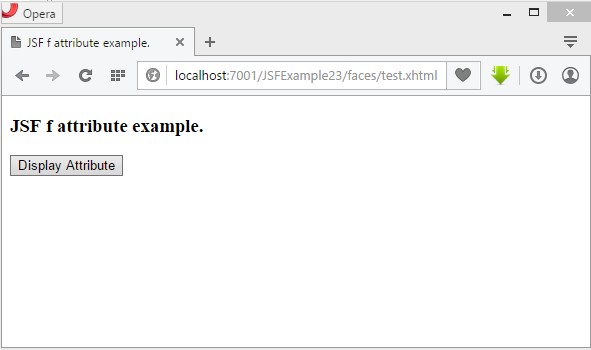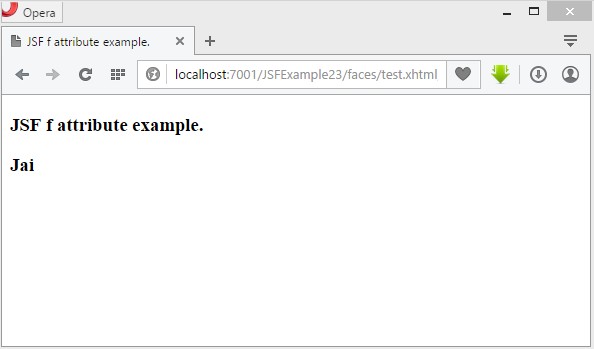JSF f:attribute tag is used to assign an attribute value to a JSF UI component or a parameter to a component which can be get via action listener.
Attributes of f:attribute tag.
| Attribute | Description |
|---|---|
| name | The name of the attribute to set |
| value | The value of the attribute |
Example:
Test.java
import javax.faces.bean.ManagedBean; import javax.faces.bean.SessionScoped; import javax.faces.event.ActionEvent; /** * Managed bean. * @author w3schools */ @ManagedBean(name="test") @SessionScoped public class Test { private String userName; public String getUserName() { return userName; } public void setUserName(String userName) { this.userName = userName; } public void displayAttribute(ActionEvent event) { userName = (String) event.getComponent() .getAttributes().get("userName"); } } |
test.xhtml
<?xml version="1.0" encoding="UTF-8"?> <!DOCTYPE html PUBLIC "-//W3C//DTD XHTML 1.0 Transitional//EN" "http://www.w3.org/TR/xhtml1/DTD/xhtml1-transitional.dtd"> <html xmlns="http://www.w3.org/1999/xhtml" xmlns:h="http://java.sun.com/jsf/html" xmlns:f="http://java.sun.com/jsf/core" xmlns:ui="http://java.sun.com/jsf/facelets"> <h:head> <title>JSF f attribute example.</title> </h:head> <h:body> <h3>JSF f attribute example.</h3> <h:form> <h:commandButton id="submit" actionListener="#{test.displayAttribute}" action="success"> <f:attribute name="value" value="Display Attribute" /> <f:attribute name="userName" value="Jai" /> </h:commandButton> </h:form> </h:body> </html> |
welcome.xhtml
<?xml version="1.0" encoding="UTF-8"?> <!DOCTYPE html PUBLIC "-//W3C//DTD XHTML 1.0 Transitional//EN" "http://www.w3.org/TR/xhtml1/DTD/xhtml1-transitional.dtd"> <html xmlns="http://www.w3.org/1999/xhtml" xmlns:h="http://java.sun.com/jsf/html" xmlns:f="http://java.sun.com/jsf/core" xmlns:ui="http://java.sun.com/jsf/facelets"> <h:head> <title>JSF f attribute example.</title> </h:head> <h:body> <h3>JSF f attribute example.</h3> <h3>#{test.userName}</h3> </h:body> </html> |
faces-config.xml
<?xml version="1.0" encoding="windows-1252"?> <faces-config version="2.0" xmlns="http://java.sun.com/xml/ns/javaee" xmlns:xi="http://www.w3.org/2001/XInclude" xmlns:xsi="http://www.w3.org/2001/XMLSchema-instance" xsi:schemaLocation="http://java.sun.com/xml/ns/javaee http://java.sun.com/xml/ns/javaee/web-facesconfig_2_0.xsd"> <navigation-rule> <from-view-id>test.xhtml</from-view-id> <navigation-case> <from-outcome>success</from-outcome> <to-view-id>welcome.xhtml</to-view-id> </navigation-case> </navigation-rule> </faces-config> |
web.xml
<?xml version="1.0" encoding="UTF-8"?> <web-app version="3.0" xmlns="http://java.sun.com/xml/ns/javaee" xmlns:xsi="http://www.w3.org/2001/XMLSchema-instance" xsi:schemaLocation="http://java.sun.com/xml/ns/javaee http://java.sun.com/xml/ns/javaee/web-app_3_0.xsd"> <servlet> <servlet-name>faces</servlet-name> <servlet-class> javax.faces.webapp.FacesServlet </servlet-class> </servlet> <servlet-mapping> <servlet-name>faces</servlet-name> <url-pattern>/faces/*</url-pattern> </servlet-mapping> </web-app> |
URL:
http://localhost:7001/JSFExample23/faces/test.xhtml
Output:

Click on Display Attribute button.

Download this example.